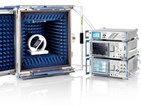Rohde & Schwarz Simplifies Measurement Of Radiated Spurious Emissions On LTE Devices

Munich - Manufacturers of wireless devices must measure the radiated spurious emissions (RSE) of their products to ensure that they will not interfere with other services. The conventional approach to measuring RSE is to filter out the high-level wireless communications signals. For the LTE standard, which uses 258 combinations of frequency bandwidths, this approach would involve tremendous cost and effort. Rohde & Schwarz now presents a significantly simpler solution that is easy on the budget – the new R&S OSP-B155 option.
Rohde & Schwarz is taking a completely new approach to measuring radiated spurious emissions on LTE devices, making it considerably easier for users to measure RSE in the presence of LTE carrier power. The solution is the R&S OSP open switch and control platform equipped with the new R&S OSP-B155 option – at a price no higher than that of a conventional test setup with notch filters.
Standardization bodies such as the ITU or the European R&TTE specify tests for measuring RSE on wireless devices. Manufacturers perform these tests during development and final acceptance testing. With conventional wireless communications techniques, the high-level radio signal can be filtered out at reasonable effort to enable RSE measurements. On the other hand, LTE defines 43 frequency bands and can transmit – at full power – in six bandwidths in each band. Filtering out all LTE signals present in each band and bandwidth would involve tremendous effort, requiring a separate cabinet solely to accommodate the 258 filters needed to cover all frequency bandwidth combinations.
The Rohde & Schwarz solution requires only two height units in the control cabinet. The new R&S OSP-B155 plug-in module shifts the entire received signal spectrum into the optimum power range to allow full use of the dynamic range of the connected EMI test receiver. The receiver can analyze the entire LTE signal spectrum without requiring a notch filter. The crucial prerequisite for a successful measurement using this technique is high receiver sensitivity. Only a high-performance EMI test receiver can detect all relevant spurious emissions. Moreover, the test receiver must have a high dynamic range to prevent peak levels of the transmitted wireless signals from distorting measurement results. The R&S ESU EMI test receiver offers high sensitivity of typically -155 dBm/Hz, combined with a high dynamic range of 80 dB in the relevant frequency range, making it an ideal choice for this type of measurement.
The R&S OSP-B155 option fits into two slots on the R&S OSP. It is designed to be used with the R&S ESU test receiver and R&S EMC32 EMC measurement software from Rohde & Schwarz. In combination with the R&S CMW500 wideband radio communication tester, which provides LTE signaling, the new RSE measurement solution seamlessly integrates also into existing applications and systems.
The new R&S OSP-B155 option for measuring radiated spurious emissions on LTE devices is now available from Rohde & Schwarz.
SOURCE: Rohde & Schwarz
